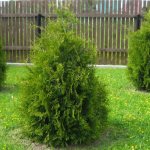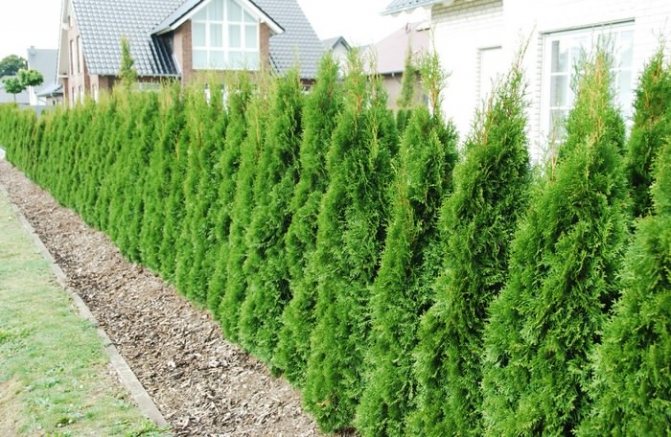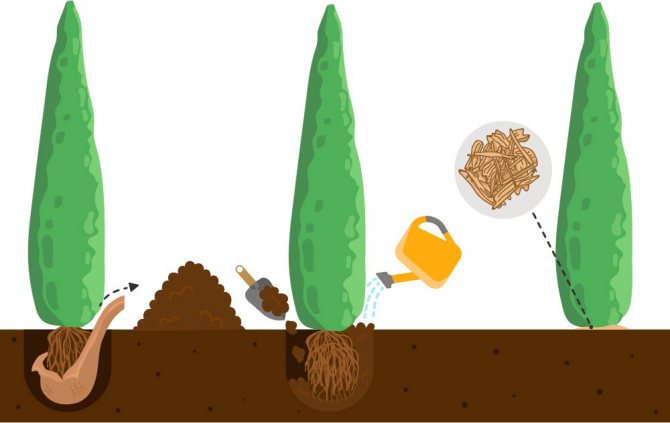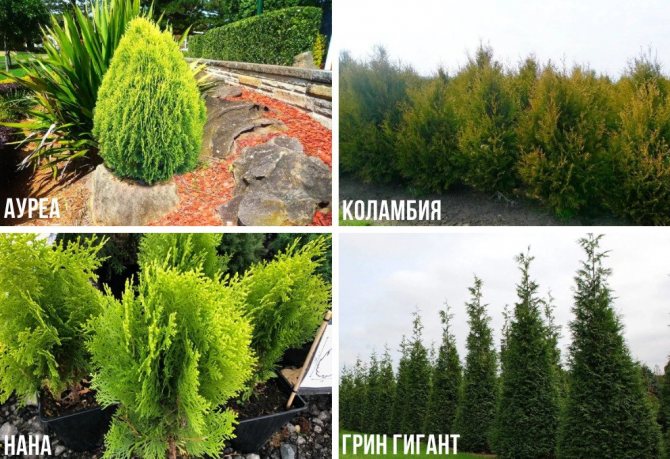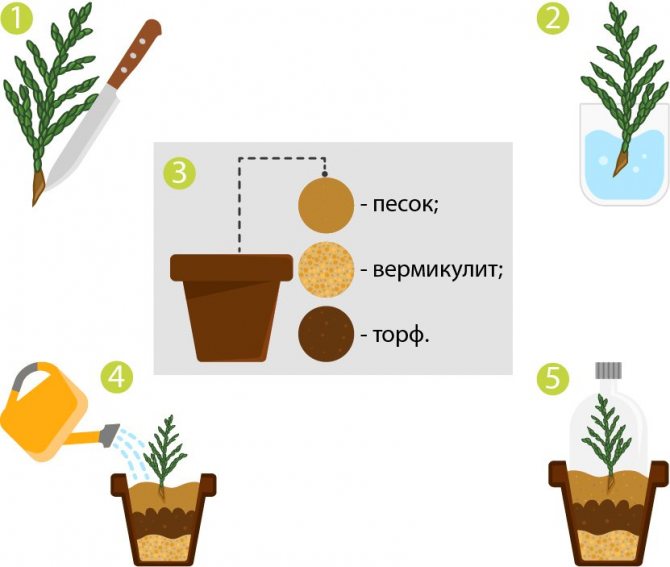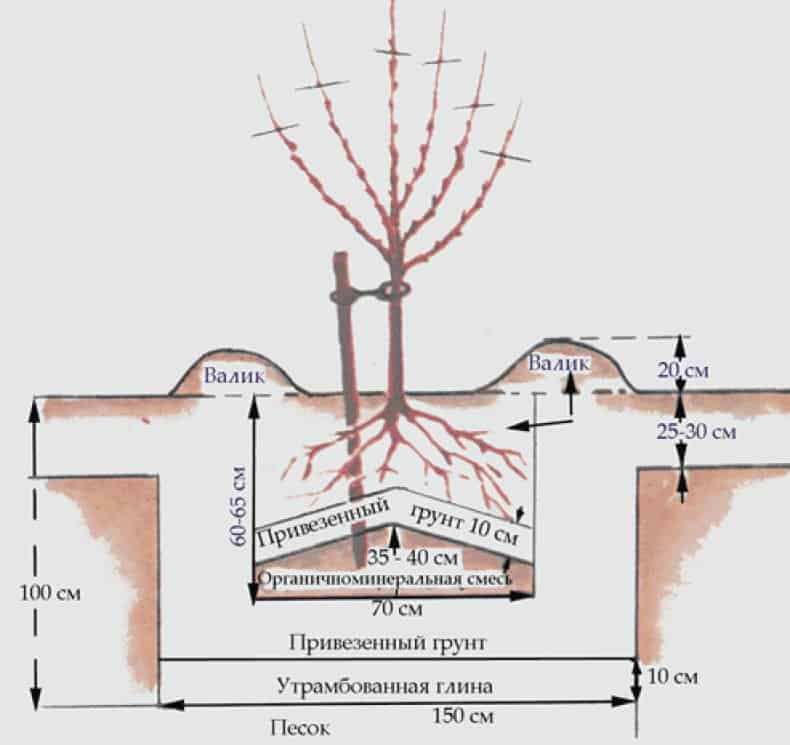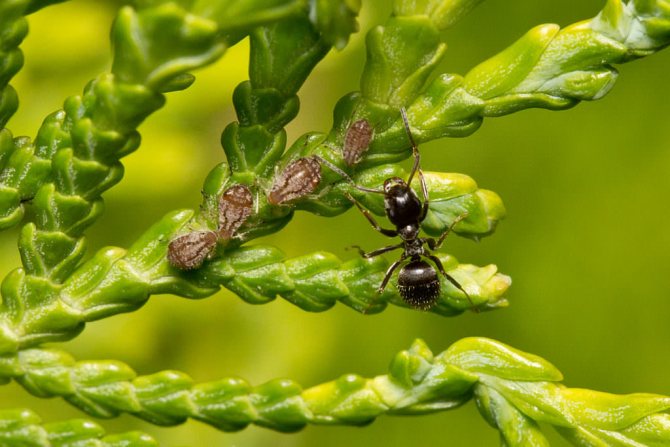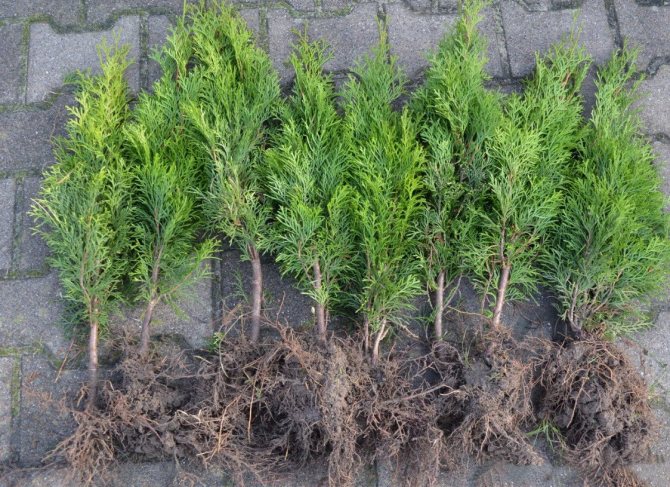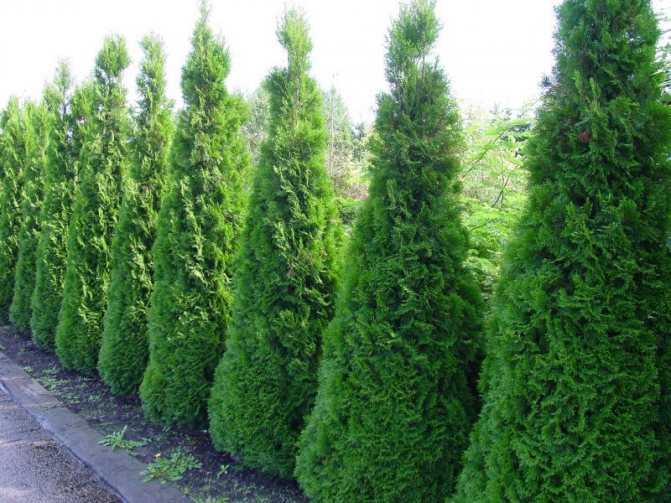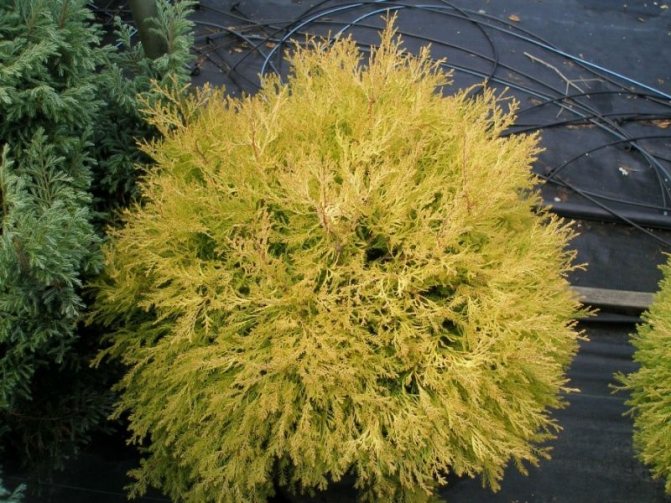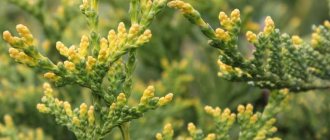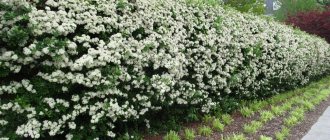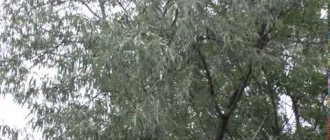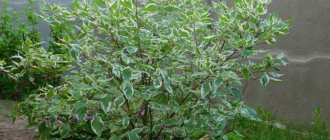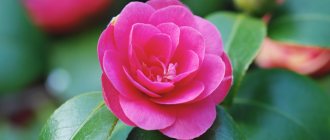Thuja smaragd western
Thuja smaragd belongs to the Cypress family. An evergreen plant can delight the eye for 50 to 100 years. The monoecious tree has a narrow and dense pyramidal shape.

Thuja mix
Thuja smaragd: description and dimensions
Thuja western smaragd is distinguished by its unique description:
- the tree grows in size from 4 to 6 m in height and up to 2 m in width. The difference in growth depends on the variety. In the wild, the height can reach 70 m;
- it has a dense crown, which is covered with needles. Designers love to create real sculptural masterpieces from it, which becomes an adornment of any landscape;
- in spring, small brown cones appear on the tree, which fall off with the onset of cold autumn;
- in Russia there are two types - a tree with a green and a golden color;
- it gives off a peculiar pleasant resinous aroma.
How quickly thuja smaragd grows
Thuja western grows very slowly. Over the year, she adds 10 cm in height and 5 cm in width.
Description
This type of thuja is not yet 70 years old, it was bred in 1950. Denmark is considered the birthplace of the variety. The plant is highly wind-resistant and frost-resistant, very unpretentious, grows on any soil and any area, purifies the air. Has a superficial root system. Caring for him is extremely simple, does not take much time and effort. The branches grow vertically upward, far from each other. They look glossy and always fresh green. The more humid and sunny the planting site is, the greener and thicker the thuja will be. In dry places, the dense crown thinns slightly.
Height of an adult plant
When choosing this tree for planting, you need to take into account that over time, the appearance will change greatly. From a small thuja sapling, a giant of an average height of 5-6 meters will gradually grow. If you plant thuja under windows, keep in mind that soon it will block your entire view. But the plant looks great as a hedge, garden compositions. Different varieties may differ in height, for example, Smaragd variegata reaches only three meters in adulthood.
How much is growing
Thuja smaragd grows very high, which takes a long time. Depending on the variety, the growth can reach from 10 to 50 centimeters per year. The tree will delight with its emerald greenery for several decades: from 50 to 150. In four years, the western smaragd species reaches a height of about 2.5 meters, the crown diameter is about 70-80 centimeters.
Planting and leaving
Tuya Brabant - description and size, fit and care
To grow a strong and healthy tree, you need to think carefully about all the details. Half of the success depends on the correct planting site. Thuja smaragd loves sunlight, however, it is not worth allowing the plant to be in the sun all day, since the rays will lead the tree to dehydration, and the blue thuja will not tolerate the winter well.
For your information! An important condition for planting is the absence of drafts.
Although the tree can grow comfortably in swamps and clay, it is still better to plant it in nutritious soil. To do this, you need to mix peat, turf soil and sand.
Thuja is planted from seeds and cuttings. Growing from seed is a difficult and time-consuming process. From the period of sowing the planting material to transplanting it into the soil, it can take from 2 to 5 years.
The cones are harvested in the year the tree bears fruit. They are placed in a warm place where they open and the seeds spill out. Only large specimens are selected for sowing.
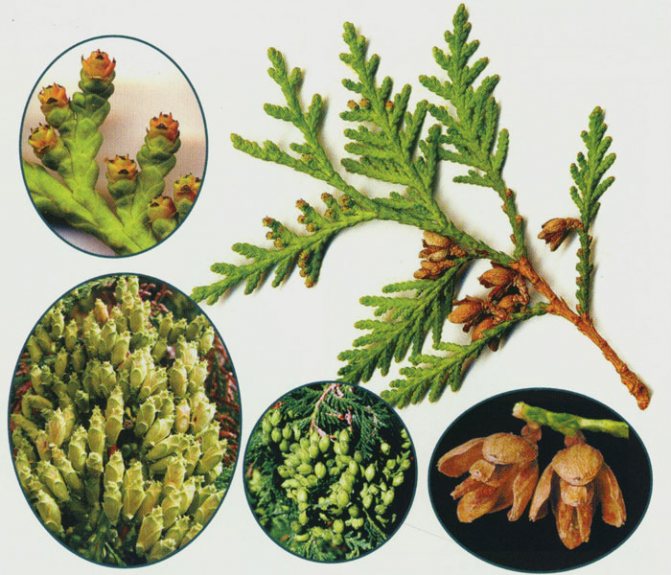

Cones with seeds
The advantage of growing a coniferous specimen from seeds is that it will form strong and will be fully adapted to the climate of the region.
For your information! The disadvantages of this method include unpredictability. The seeds of this cypress can lie in the soil for about 6 months without showing any signs of life. And the second drawback is the lack of varietal affiliation.
In order for the process of growing thuja from seeds to be successful, you need to adhere to certain rules:
- the fruits are sown in wet sand and cover the pot with a film;
- the future crop is placed in a refrigerator or a cool place for 2 or 3 months with a temperature of about 6 ° C;
- sowing must be monitored, periodically remove the film and ventilate so that condensation does not accumulate;
- in February, the plant is transplanted into soil made from turf, peat and sand. For the purpose of disinfection, the soil is watered with a solution of potassium permanganate. Plants are placed in a room with a temperature of 20 ° C;
- when the sprouts grow up, they are moved to a cool place and provided with good lighting;
- you need to apply mineral fertilizers to the soil 2 times a month;
- when the seedlings are 2 years old, they dive. In summer, pots with plants are taken out into fresh air and placed in partial shade;
- in the third year, the seedlings are planted in larger containers. When they reach a height of 50 cm, they are planted from the nursery to the street in their permanent habitat. This happens no later than five years after planting the seeds.
Gardeners also practice outside planting. Collected in the fall, it is better to plant them in boxes, since the young plant looks like dill and is easily confused with weeds. The branches of the tree appear when it is 6 months old.
For your information! At 3 years old, it is reasonable to transplant seedlings in large containers, and after 6 years, the boxes are removed altogether.
Preparatory work before landing
Before planting a tree, you need to carry out several preparatory steps, which not every novice gardener knows about.
Therefore, let's start with how to plant thuja "Smaragd" in the spring. First, let's prepare the site. If the tree was bought with a pot, then pour abundantly an earthen lump with water and leave to stand for an hour or two to make it easier to remove. Estimate the diameter of the pot and dig a planting hole that is 2-3 times larger than the earth ball. In the event that the seedling is purchased without an earthen coma, a pit for planting is dug 3 times larger than the diameter of the crown at its widest point.


After that, the pit must be filled with fertile soil. There are several options for the "desired" soil: black soil, turf soil, compost, soil from a flower shop, peat or any other soil that fits the parameters described. We recommend using the following mix: peat, sand, chernozem / flower soil in a 2: 2: 1 ratio. This soil contains all the necessary substances for the initial stage. If the thuja has a height of less than 1 m, then a complex fertilizer ("Kemira", nitroammofosk or their analogs) must be added to the planting soil.
Important! If the soil is damp or heavy, then the hole is deepened by 20 cm and a layer of gravel, fine gravel or expanded clay is covered.
How to plant thuja emerald
Thuya Golden Smaragd - description
More than one gardener is wondering how to plant thuja emeralds and how much space they need.
Step-by-step landing instructions:
- You need to dig a hole with a diameter of about a meter and a depth of no more than 80 cm.
- Line the bottom with a drainage layer, then pour soil mixed with 2 tbsp into the hole. ash and mineral fertilizers.
- The seedling is placed so that the root collar is above the surface.
- If there is a desire to form a hedge from a thuja, then the plants are planted at a distance of no more than one meter from each other. For free growth, you need 2-5 m between trees. Such living fences will give odds to any creeping bushes, which are also made by hedges.
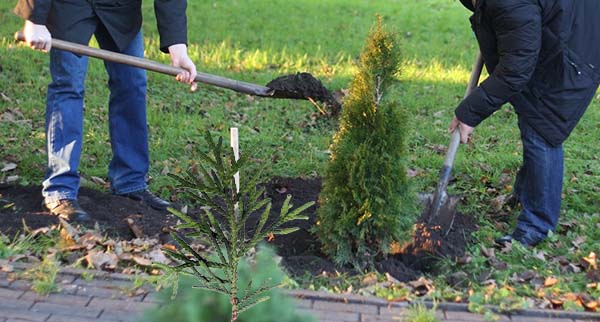

Planting thuja in the soil
Watering mode
The regularity of watering depends on the rainfall. On hot days, the tree is watered every 3 days. You need to use at least 10 liters of water per plant. Watering is carried out in the morning or in the evening. Also, the tree needs to be sprayed regularly.
Important! In the absence of drought, it is enough to water it a couple of times a month.
Top dressing
For thuja, as for other conifers, it is very important to ensure proper feeding. However, it is worth remembering that you should not overuse fertilizers. An overabundance of minerals can negatively affect the development of the tree.
Top dressing must be applied both during planting and throughout the entire period of active growth of decorative thuja. Although an adult tree has a well-developed root system and is able to independently extract nutrients from the soil, it also needs feeding.
Fertilization is divided into several stages:
- When planting, ash and compost are added to the soil. One hole accounts for 3 kg of ash, which is sprinkled on the bottom, and a bucket of compost is mixed with the soil. After that, no fertilizer is applied for a whole year.
- The next feeding is carried out in the spring. Mineral substances are introduced into the soil, which contain: nitrogen, phosphorus, potassium, calcium, iron and other useful substances. This happens at the beginning or at the end of March, it all depends on the weather conditions. If the thuja did not endure the winter well, then you need to help her get stronger. For this, root is suitable.
- It is important to feed the plants at the end of summer. During this period, humus is used, which not only nourishes the plants, but also protects them from fungus.
Important! In no case should fertilizers containing nitrogen be applied in summer. They are introduced only in March.
Experienced summer residents identify several golden rules for fertilizing:
- you cannot add different dressings that have almost the same composition. Overdose may occur;
- between fertilization of the soil should pass at least 2 weeks;
- the day before fertilizing, the soil must be watered;
- in the fall, all feeding is stopped.
Thuja care during the growing season
Thuja does not need special care. You just need to remember the basic rules:
- prevent the crown and soil from drying out, for which you need to regularly arrange a water shower for the crown and abundant watering for the roots, followed by mulching the ground under the crown, using peat or cut grass for this;
- do not get carried away with fertilizing, especially nitrogen fertilizers and manure. Excess nitrogen leads to a change in color and uncontrolled growth of needles in an unplanned direction. The tree becomes "shaggy" and loses its decorative effect. During the growing season, fertilizers are applied 2 times, mainly potash and phosphorus. The best result can be observed after feeding with a special fertilizer for conifers in a chylate (easily assimilated by the plant) form. These fertilizers allow you to get not only a strong, strong plant, but also provide a rich color and density of the needles. All feeding should be stopped in August!
- remove weeds and loosen the trunk circle, trying not to damage the roots, since they are located at a depth of 6-8 cm;
- regularly remove dried and diseased branches.
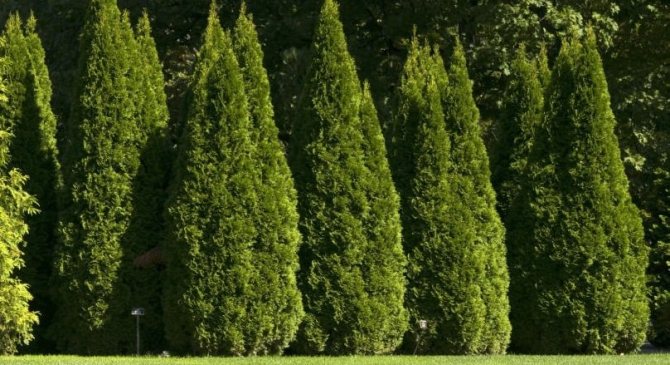

Pruning
Competent pruning of thuja smaragd is an indispensable condition for its normal development. Types of thuja pruning:
- plucking - yellowed coniferous plates are removed with hands, without touching the branches. This is the most gentle way to rejuvenate thuja, used for young thuja;
- thinning - with pruning shears or scissors, the branches are cut out at the trunk, without leaving a hemp;
- haircut - removal of the apical part of the shoots with a pruner;
- rejuvenation - cutting out old shoots with damaged bark.
In tall trees, the tops are cut off, after which they will grow in breadth, and not upward. Dried and diseased branches are cut off at the base, others are removed selectively, which contributes to the resistance of thuja to diseases and pests, strengthening the immune system.
It also improves air circulation inside the crown and the illumination of the needles. Lush branching will occur if the tips of the branches are cut off.
Tips for Correct Cropping:
- The best time for pruning the crown is from early summer to mid-August.
- It is better to correct the shape of the crown more often, but little by little, not allowing the branches to bend into arbitrary shapes.
- When performing this procedure, it is necessary to observe the peculiar rules of hygiene, using a sharp and clean instrument, which will allow the plant to recover faster.
- It is not advisable to prune after rain. In this case, the risk of pathogens entering the wood from the wet crown increases.


Thuja decorative haircut
Thuja is a very malleable plant, which is why it is a favorite of landscape designers. A wide variety of garden sculptures and architectural forms can be made on the basis of this tree.
Spiral, triangular, square and other figures for decorating a garden, alley, front entrance can be performed with only a garden shears and a mechanical or electric pruner. Before the start of a curly haircut, the intended shape is outlined with twine or colored markers.
Important! Forming a plant involves cutting off 1/3 of the entire green mass at a time, nothing more, otherwise the ephedra will receive enormous stress.
Thuja retains the shape given to it for a very long time.
Features of summer care
Tuya Holmstrup (Holmstrup) - description and dimensions
On hot summer days, the thuja should be protected from the scorching rays. For this, a small structure above the tree is suitable.
Periodically, you need to remove weeds and eliminate insect nests. Loosening the soil regularly will provide good air circulation to oxygenate the roots.
It is useful to mulch the soil once a year. This will protect the area from weeds and retain moisture.


Soil mulching
Varieties
There are several main varieties of thuja Smaragd:
- Golden... Its difference is in a delicate golden shade and soft fluffy crown;
- Variegata... The peculiarity of this variety is its high growth, which can reach 3 meters. Has a rich emerald hue;
- White... It has an unusual shade of needles, which gives the impression that the plant is covered with snow;
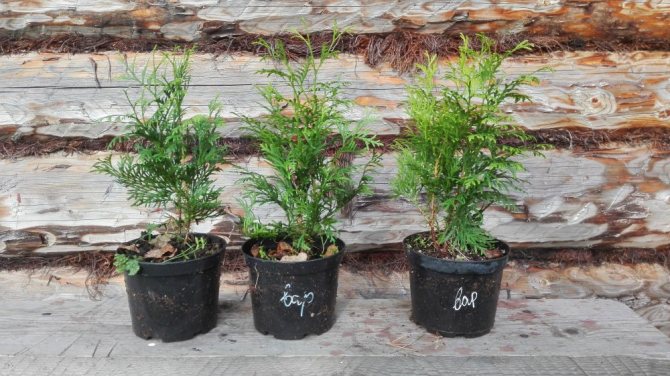

Variegata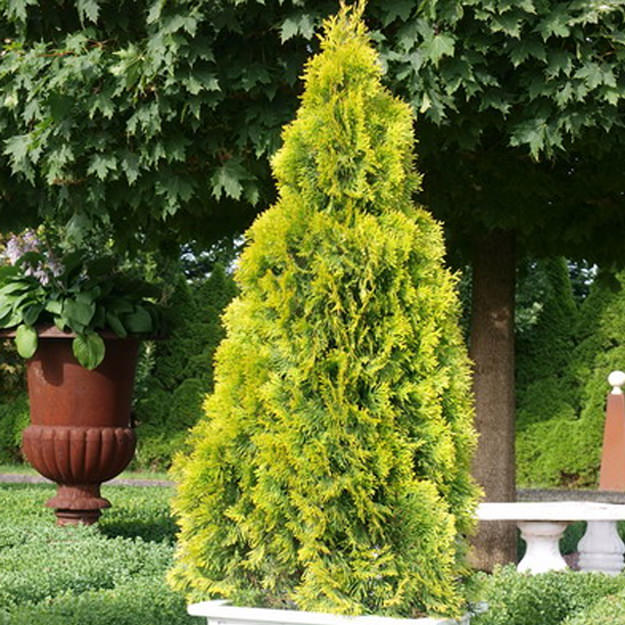

Golden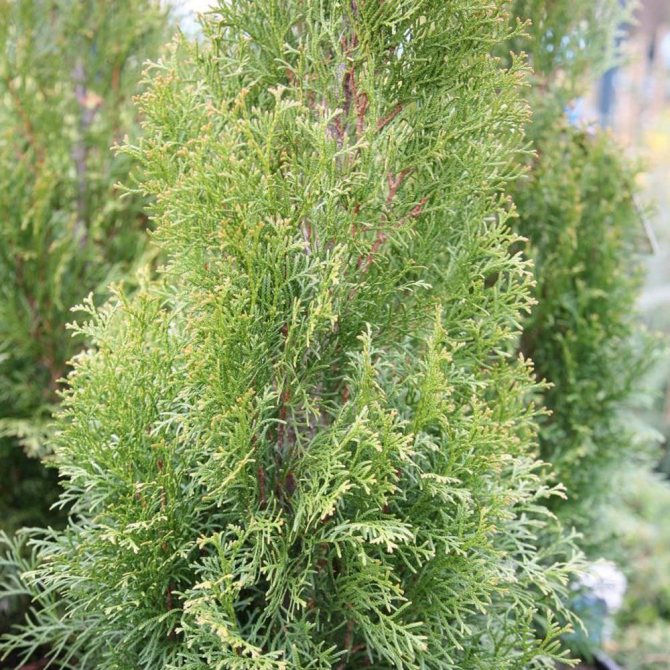

White

Spotty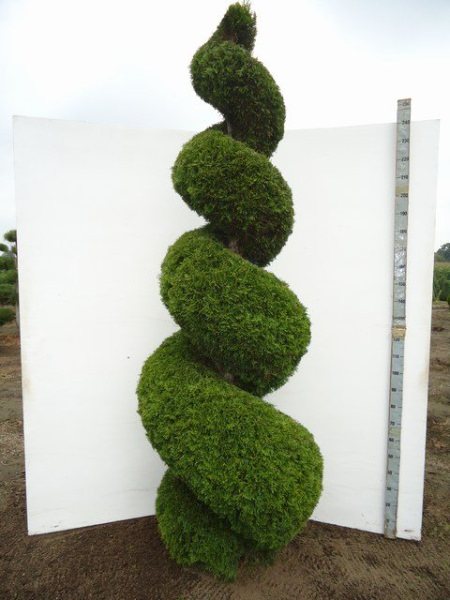

Spiral - Spotty... This type of tree has a loose structure, due to which the impression of a gorgeous crown is created;
- Spiral... The variety is considered unique due to the spiral growth of the plant.
Preparing for winter
Young seedlings of the first year of life must be covered. Mature trees can survive the winter outdoors. A frame is built around the seedlings and covered with a non-woven white material. This design will allow the snow to slide off the top, and not linger on the branches of the trees.
You also need to take care of the root system, otherwise the tree will dry out. To do this, the leaves are mixed with the ground and sprinkled over the area. This mixture will help retain moisture in the soil, and rotted leaves will also serve as fertilizer.
Preparation for winter is carried out in the fall before the snow falls.
Important! In winter, it is necessary to ensure that snow does not lie on the thuja, otherwise the needles may rot.
With the onset of spring, do not rush to open the tree. It can be damaged by sunlight. You should wait until the earth dries out, and the outside temperature will be above zero.
How to choose the right seedlings when buying
Choosing the best seedling is a whole science.
When buying a thuja "Smaragd" seedling, you need to pay attention to the size of the crown, the color of the green part of the plant, inspect the trunk and branches. If the thuja is not sold in a pot, then first of all inspect the roots.
Important! Buy seedlings in your region so that the tree does not waste energy on acclimatization.


A good seedling should have tough, lettuce-colored leaves. The height of the tree should be no more than 120 cm. The trunk and shoots should have a uniform color, without too light or dark areas. The bark should be solid. Check for any holes or damage in the bark, as damaged bark can weaken the tree severely and it will not take root. Various holes are, possibly, the presence of pests in the bark or bast. And such a neighborhood threatens not only the young thuja, but also other conifers in the garden.
If the aboveground part is in order, go to the roots. Ideally, the plant should be sold in a pot of soil (the soil should not be dry!). If the roots are not in the ground, then check their moisture and integrity. Too dry or damaged roots are a reason to refuse to buy a seedling. However, if the root system is waterlogged and an incomprehensible mucus is visible on it, then the roots begin to rot and it is not worth buying such a seedling. It is important to understand that a weakened tree requires much more energy and time from the gardener to acclimate and grow.
Did you know? All types of western thuja are distinguished by a high level of phytoncidity. Inhalation of air saturated with phytoncides helps to strengthen the immune system.
Reproduction
Reproduction of thuja at home occurs with the help of seeds, twigs and cuttings. Sowing seeds has already been mentioned above, and now we will talk about less painstaking methods of reproduction, which include twigs and cuttings.
In order for the branches to start, the cut site is treated with growth stimulants and placed in a box. Several branches can be planted in one pot, the main thing is to maintain a distance of 3-5 cm between them.
In spring, mature plants can be placed in a greenhouse, and in summer they are already planted in their permanent habitat.
Propagation by cuttings
The propagation method by cuttings is the simplest. This process takes place in the fall. Strong and healthy shoots are used in the role of planting material. The cuttings should not be too young or too old. It is necessary to pick up shoots from the middle of the trunk.
Important! Cuttings are chosen strong, but not yet stiff. You need to tear them off so that a small piece of wood remains at the tip. It is called the heel. The length of the cutting should be 50 cm.
The shoots are planted in prepared soil, which is a mixture of peat and leafy soil. They are taken in equal amounts.
During the breeding process, the following recommendations should be followed:
- extra leaves must be eliminated, and those that remain must not touch the peat;
- you need to install a greenhouse for the cutting, a transparent glass jar is suitable for this;
- seedlings are placed in a warm place. The air humidity should not exceed 70%, and the temperature should reach about 23 ° C, otherwise the sprout may rot;
- ideally, it will not be watering at the root, but regularly sprayed.
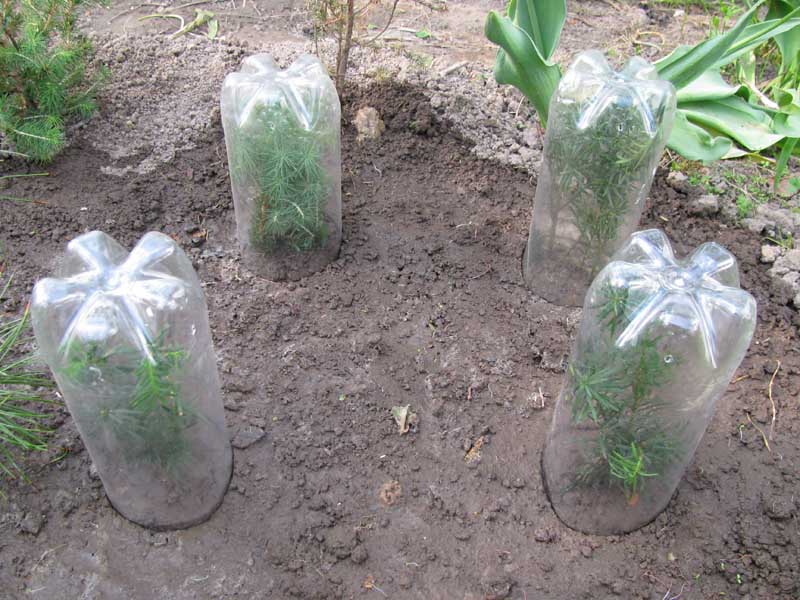

Propagation by cuttings
If new shoots appear on the thuja, it means that it has successfully rooted. However, you should not rush to plant a tree in the soil. First, the greenhouse must be ventilated, gradually accustoming the cuttings to fresh air.
Fast growing varieties of thuja
Interesting. In nature, there are 5 varieties of thuja: western, eastern, Japanese, Korean, folded. The most common variety, the western one, is a pyramidal tree. Thuja reaches 15-20 m in height, the crown is 3-5 m in diameter. An indicator of the speed of plant growth is how many centimeters the thuja tree grows per year.
Setting up a tall evergreen hedge requires accelerated plant growth. Fast growing thuja - varieties:
- Brabant.It is a columnar plant growing up to 20 m. The conical crown reaches a diameter of about 4 m at the bottom. The annual growth is 30-40 cm in height and 10-15 cm in breadth. The needles are large, malachite shade. For good growth, Brabant needs a sunny place, tolerates light shade. The soil is moist fertile loam. High degree of frost resistance.
- Golden Brabant. This is a new variety of Brabant with yellow-green needles.
- Columna. Thuja has a narrow columnar crown. The growth rate of thuja is high - annually the plant adds 30-40 cm upward and about 5 cm in width. The total height is up to 10 m, the volume of the crown is up to 1.5 m. The needles are scaly, the color does not change. Any soil is suitable, from acidic to alkaline. Very hardy.
- Fastigiata. Tall and fast growing variety of columnar thuja. The crown has a narrow conical and columnar shape. The annual growth rate is about 30 cm in height, 5 cm in width. The growth of an adult plant reaches 15 m, the diameter of the crown is 3 m. The needles are dark green in color, they are soft and have a resinous aroma. In appearance, thuja resembles a cypress. The lifespan is about 200 years. Thuja Fastigiata is frost-resistant.
- Thuja folded or giant. The plant reaches 15 m in height, 3-5 m in width. Height can increase up to 30 cm per year. The needles are green, dark, shiny, there are white spots on the underside. Has a strong aroma. A winter-hardy variety of thuja, but does not tolerate high temperatures.
Thuja needles turn yellow: what to do
Many gardeners are wondering why thuja turns yellow. This happens for many reasons. The main ones include:
- natural processes. The foliage of the needles dies off after 3-5 years, therefore it turns yellow and dries up;
- seasonal changes. Some varieties of thuja acquire a golden-bronze color in winter;
- improperly selected soil. If the thuja is planted in sandy soil, then it will lack moisture, which quickly goes into the ground, and the seedling will turn yellow. There are not enough nutrients for the sprout in the clay soil, but water can stagnate in the peat, and the tree will rot;
- care errors: insufficient watering, thickened planting, poor lighting, lack of phosphorus, nitrogen and iron, low air temperature;
- the presence of pests: scale insects, miner moths, leafworms, spider mites, etc. These parasites do not mind taking advantage of the leafy part of the thuja. Insecticides should be used in the fight;
- tree diseases, the same as in juniper: brown shute, late blight. Herbicides will help in the treatment.
What to do when thuja turns yellow?
For your information! If you start caring for the plant in time, then its yellow foliage can still be saved, otherwise it will die.
Thuja pests and diseases
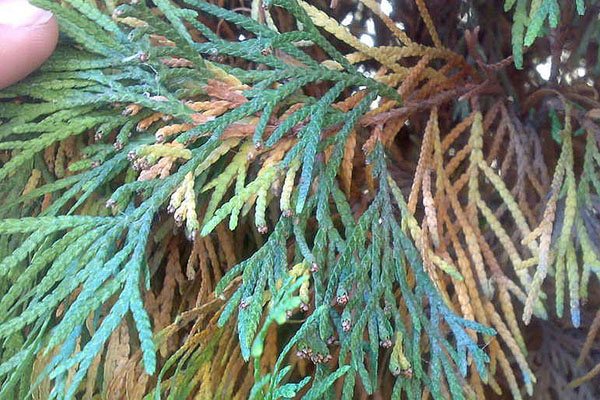

Thuja, as an ornamental plant, is often attacked by insects and some diseases. Here are the most common ones:
- Fungal infection. It is easily distinguishable by brown shoots and yellow needles. Cut off affected shoots as soon as you notice them and burn them. And then, spray the entire thuyu with foundation.
- Thuvaya aphid. This infection can destroy the entire tree. You can destroy aphids and cure the tree with the help of karbofos.
- False shield. This disease is also easy to recognize by the presence of a bump-like growth on the needles. To eliminate the infection, use the preparations rogor and karbofos.
- Tree disease due to dry soil or over-watering. Both will contribute to the rapid rotting of the soil, after which the tree will inevitably die.
Perhaps these are all diseases of thuja Smaragd.
Use in landscape design
Thuja Smaragd is an impeccable option for decorating any garden.
There are several ways to use it:
- For hedge formation... Due to its high size and dense crown, the hedge will provide protection from the wind. Can be used to divide an area;
- For designing various compositions in the garden;
- Often used as a separate decoration;
- To surround garden paths.

